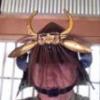-
Posts
14,158 -
Joined
-
Last visited
-
Days Won
265
Content Type
Profiles
Forums
Events
Store
Downloads
Gallery
Everything posted by Bugyotsuji
-
The starting tsuba looks to be shinchū or brass to which a patinating agent has been added, or am I being unfair? The holes are not exactly round, though, so not simply drill work. The Hosokawa were Christian; the original conception, the kuyō and cross blend, was quite a clever inspiration.
-
-
-
Does anyone feel confident with this brush writing? Just wondering if there is a Shunga-esque element to the print.
-
Well give him a heart!
-
This old NBTHK certificate for a Koshiraé, right?
-

Translation assistance for old sword receipt
Bugyotsuji replied to PNSSHOGUN's topic in Translation Assistance
¥150, but the date of 26 must be… Meiji 26??? (1893) Not Showa 26, 1951…(?) -
Traditional Ro-zuke (at over 450 degrees) is different from modern Handa-zuke (at less than 450 degrees).
-
(There was a time in the early to mid 20th C when an ivory substitute was in fashion, creamy celluloid with Schreger-type striations. Not applicable here.)
-

Accessories for the Tanegashima
Bugyotsuji replied to Bugyotsuji's topic in Tanegashima / Teppo / Hinawajū
That’s quite elaborate, Gary. Is it actually a tortoise/turtle shell or made to look like one? Do the lacquer lines emphasize natural features? I once had a black one but it was too realistic (probably genuine carapace) so having had a traumatic experience as a child, I quietly moved it on! -
As above. Probably three separate sections have been attached. Would not really function as a netsuke. NLO at best.
-
Sat in on a two-day workshop as a habaki creation interpreter for a shirogané-shi and was stunned by the serious amount of detailed work and the numbers of materials, tools and processes.
-
Satsuma bits? Thinking back through my grey matter, just for reference. (Not offering for sale!) All I’ve scraped together over the years. Sadly one katana was quickly ripped from my grasp. 1. Satsuma rustic vase (Tokkuri?) with large ‘kutsuwa’ cross. 2. a) Two Satsuma hitoribiraki priming powder flasks b) Three coarse blackpowder flasks, one with large red lacquer Satsuma ‘kutsuwa’ cross. 3. Satsuma gunyō-zutsu long matchlock. 4. Various little oil lights, oil pots and wick weights from the region. 5. Netsuke of farming lady. 6. Small Naminohira ‘Kaiken’ Tantō. And that’s about it.
-
A wasp and a persimmon? What a great object! Congratulations. The uchidashi is nice, as are the fish latch and 蝶番 ‘Chō tsugai’ butterfly hinges. No markings?
-
If there is a second, smaller hole alongside the spout, then it would have carried water. Water canisters are often sold by dealers as ‘gunpowder’ flasks. A doctor’s sword variation, possibly, also looking the part as chatō for tea ceremony.
-
-

Going to Japan... with swords...
Bugyotsuji replied to Rivkin's topic in General Nihonto Related Discussion
If you are bringing in 30 blades, I wonder if there might not be some special governmental cultural dispensation, seeing that you are also providing work for traditional Togishi. -
Overall weight would have to be a consideration, unless the warrior wished to show off. During the attacks on Nagashino Castle before the great battle at Shitaragahara, warriors scaled the rocky face from the river below; for that they wore their Nodachi on their backs. Quite possible that they also carried a metezashi.
-

A Nihonto Exhibit at Home
Bugyotsuji replied to cookiemonstah47's topic in General Nihonto Related Discussion
Many people in Japan will bring things out only if they ‘like’ the visitor! -

A Nihonto Exhibit at Home
Bugyotsuji replied to cookiemonstah47's topic in General Nihonto Related Discussion
Welcome. Why don’t you give us your ideas first, Khalid? We do have several threads here showing off people’s personal displays, their stands, their cases, their accessories, their lighting, etc. Maybe take some time to look through those first and get some inspiration? -
Bishū Osafuné Katsumitsu Nōshū Seki Takeyama Yoshinao Saku
-

Going to Japan... with swords...
Bugyotsuji replied to Rivkin's topic in General Nihonto Related Discussion
Japanese bureaucracy loves repetition of the obvious. The facts, the facts, the facts, well in advance, then again in advance, and finally on the spot, and make sure to keep all records. That you did tell them in advance. In Japanese even better. Even then, they will surely ask for some detail you had not anticipated. Keep your explanations minimal. Be prepared to be taken off to a separate room where they may ask you to fill out forms in Japanese. If you have connections or invitations from Japanese dealers, Togishi, etc., make sure to have all that correspondence, contact details etc., ready to hand. A regular courier might be able to help you with detailed advice, but trade secrets etc., would they be willing to share? Expect it to be a hassle, and to take several hours of everyone’s time at the airport, but ultimately not absolutely impossible. (Just to get the ball rolling here.)











